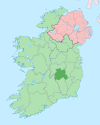Ballaghmore, County Laois
Ballaghmore
an Bealach Mór | |
|---|---|
 Ballaghmore Townland | |
| Country | Ireland |
| Province | Leinster |
| County | County Laois |
| Time zone | UTC+0 (WET) |
| • Summer (DST) | UTC-1 (IST (WEST)) |
Ballaghmore (historically Bellaghmore, from Irish: an Bealach Mór)[1] is a small village and townland (of 172 acres) located on the western side of County Laois, Ireland, southwest of Portlaoise. It is situated in the civil parish of Stradbally in the historic barony of Stradbally.[2]
Ballaghmore Village
The main industry in Ballaghmore is farming. The village has a thriving community, with a hurling club, Kyle GAA and a local church. Family names from this area include Keogh, O'Grady, England, Gilmartin, Rigney, Phelan, Delaney and Maher.
Ballaghmore Castle
The town is mainly known for Ballaghmore Castle which is situated in a truly beautiful landscape, with excellent walking and mountain climbing opportunities. The castle derived its name from the Bealach Mor, the ancient road to Munster on which the castle is located.
Ballaghmore Castle was built in 1480 by the Irish chieftain Mac Giolla Phádraig, translated as Son of the Servant of Patrick (nowadays often called simply Fitzpatrick). Like many other castles Ballaghmore Castle was damaged by Cromwellian forces in 1647 during the Laois-Offaly Plantation.
A Mr. Ely restored the castle in 1836 and found a hoard of gold on the land in the process. Ely was killed by an angry farmer and never lived in the castle. The uninhabited building was used as granary and fell in disrepair until it was bought by its present owner in 1990.[3] Of all the castles of Upper Ossory, it is the only one which is still inhabitable.
Sheela na Gig
A very interesting feature of the Ballaghmore Castle is the Sheela na Gig which is carved in a corner stone of the outer front-facing wall.[4][5] The sheela-na-Gig is depicted as an ugly, half-dead, woman with contorted face and fully exposed vagina. The emphasis on the female reproduction organs in combination with her deathlike appearance is associated with the cycle of birth and death. Sheela-na-Gig is thought to be a Celtic fertility goddess. Scholars assume that Sheela-na-Gig is imported from Mesopotamia where the term nu-gug refers to some sort of sacred prostitutes. Sheela-na-Gig figures were common in Ireland and Britain, but just a few of them survived the Victorian nineteenth century.
See also
References
- ^ Placenames Database of Ireland
- ^ "Ballaghmore". IreAtlas Townlands Database. Retrieved 20 April 2015.
- ^ http://www.castleballaghmore.com/index.php
- ^ http://www.castleballaghmore.com/index.php
- ^ http://megalithomania.com/show/site/1243/ballaghmore_sheela-na-gig.htm

